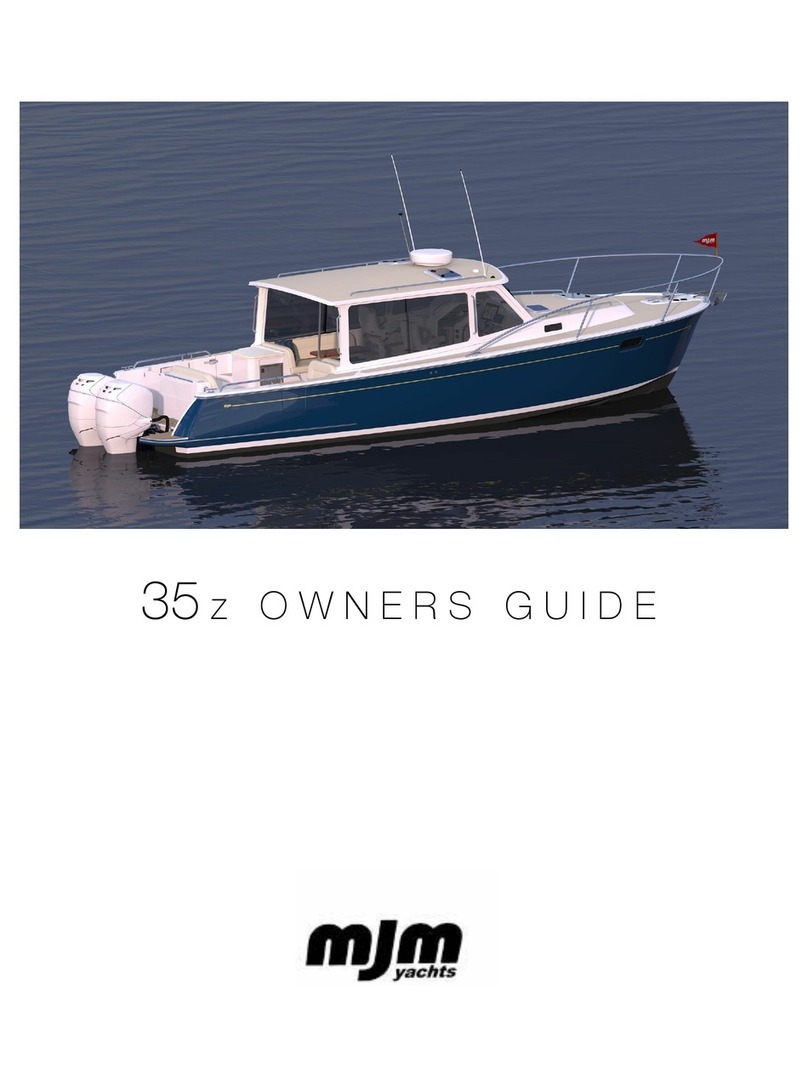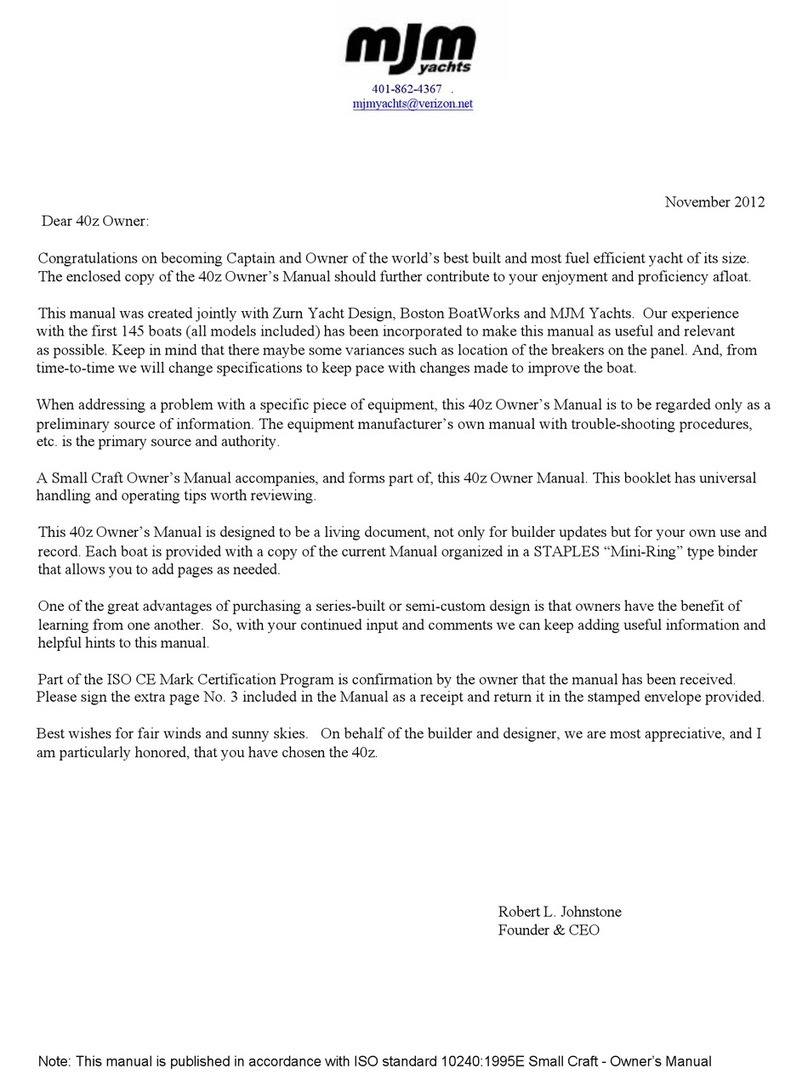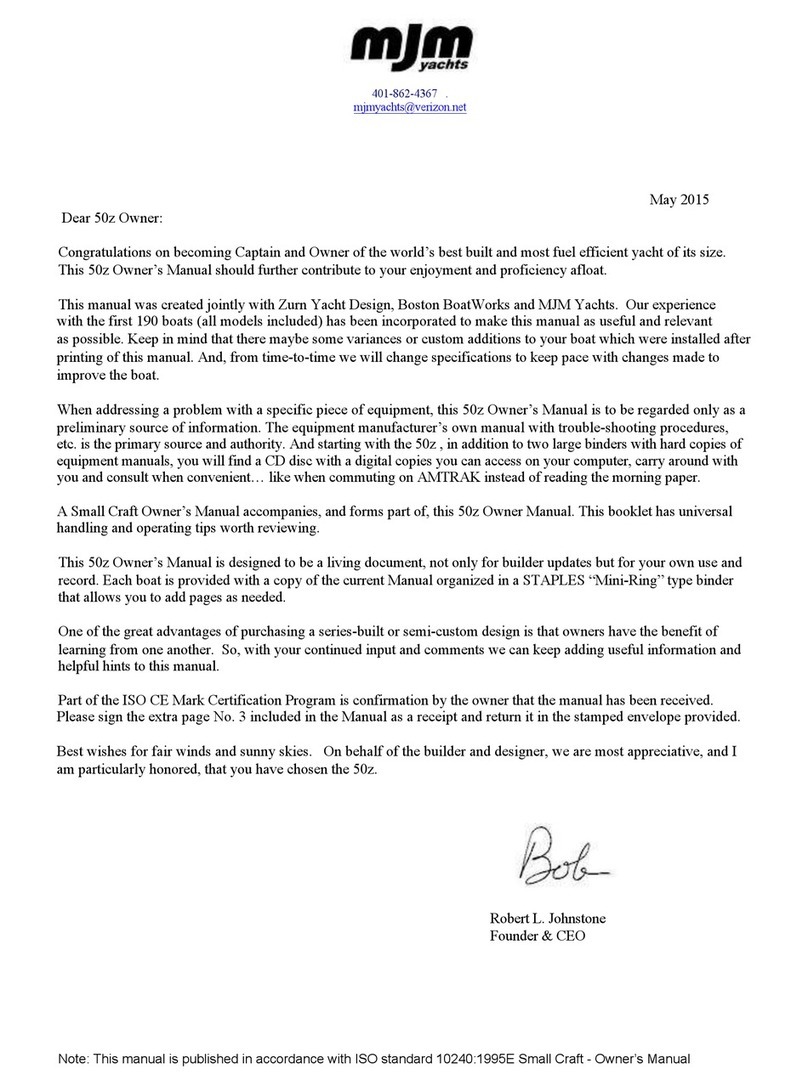TABLE OF CONTENTS
1 INTRODUCTION 1
1.1
Purpose and Limitations
..................................
1
1.2
Standard Specifications
...................................
1
1.3 Conventions..................................................1
2 SAFETY and some USCG REQUIREMENTS 2
2.1
Binder Manuals
...................................................
2
2.2
Standard Equipment
..........................................
2
2.3
Commissioning Package Safety Items
........
3
2.4
USCG required equipment
.............................
3
2.5
Additional Safety Equipment
...........................
3
2.6
Some Additional USCG Requirements
.......
3
2.7
Fuel Shut-off Valves
..........................................
4
2.8
Fire Suppression
................................................
4
2.9 Notices...........................................................4
2.10
Emergency and Thru Hull Diagram
...............
5
3 PROPULSION 6
3.1 Engines..........................................................6
3.2
Engine Checks
....................................................
6
3.3 5 Steps to Start ...........................................7
3.4
Stopping the Engines
.......................................
7
3.5
New Engine Break-in
........................................
8
3.6
Operating Parameters
.......................................
8
3.7
Leaving the Boat
................................................
8
3.8
Mercury Verado 300 & 350 HP Engines
....
9
4 INSTRUMENTS AND CONTROLS 10
4.1
Helm Station
.....................................................
10
4.2
Mercury Features and Controls (pages 56 -
77) 11
4.3 Joystick Piloting....................................... 11
4.4
DISPLAYS
.........................................................
12
4.5
Compass Heading and Calibration
............
12
4.6
Trimming the MJM3
........................................
12
4.6.1
Engine Trim
.....................................................
12
4.6.2
Mercury Active Trim
.......................................
12
4.6.3
ZipWake Auto Trim
.......................................
12
4.7 Searchlight ................................................. 13
4.8
Multi-Function Display (MFD)
.......................
13
4.9
Console Switch Panel
....................................
13
4.10
Windshield Operation
.....................................
14
5 ELECTRICAL SYSTEMS 15
5.1
Electrical Safety
..............................................
15
5.2
Electrical Power
...............................................
15
5.3
Shore Power
.....................................................
16
5.4
Fuse Locations
................................................
16
5.5 24-Hour Circuits ........................................ 16
5.6
The 12V DC Panel
.........................................
17
5.7 The 120V AC Panel.................................. 18
5.8
Westerbeke
3.5
SBCG
Generator
(Option )19
5.9
Generator Component Locations
..............
20
5.10
Victron Inverter/Charger
................................
21
5.11 Bonding....................................................... 21
6 WATER SYSTEMS 22
6.1 Fresh Water................................................ 22
6.2 Hot Water.................................................... 22
6.3 Gray Water................................................. 23
6.4 Raw Water.................................................. 24
7 SEAKEEPER GYROSTABILIZER (Option) 25
7.1 To Start the Gyro....................................... 25
7.2 Activate/De-activate.................................. 25
8 EQUIPMENT, APPLIANCES and FINISHES 26
8.1 Anchor Windlass........................................ 26
8.2 Anchor Washdown.................................... 26
8.3 Fusion Multi-media Player ....................... 26
8.4
Privacy/Sunscreen Curtains (Option)
.........
27
8.5 Cooktop....................................................... 28
8.6 Microwave................................................... 28
8.7 Refrigerator................................................. 28
8.8 Ice maker.................................................... 28
8.9 TV (optional)............................................... 28
8.10 Vacuum Flush Head System................... 29
8.11 Air Conditioning (Optional) ...................... 29
8.12 Finishes....................................................... 30
9 APPENDIX 31
9.1 The Top 10 Causes of Engine Failure.... 31
9.2 Diesel Operation........................................ 32
9.3 Starting with Low Batteries...................... 34
9.4 Winter Storage........................................... 35
9.5 Spring Commissioning.............................. 36
9.6 Hauling Out and Blocking ........................ 36
9.7 Trailer Loading Checklist.......................... 36
9.8 Fuel Consumption..................................... 37
9.9 Routine Maintenance................................ 38
9.10 Boat Lift and Bunk Offsets....................... 39
9.11 Systems Location Plan............................. 40
9.12 Systems Key.............................................. 41
9.13 Wiring Diagrams........................................ 42
9.14 Fuse Locations & Specifications............. 43
9.15 Fuel Consumption Log ............................. 44
9.16 Pamlico Yachtworks Limited Warranty.......4
45
5
THE MJM TEAM
10.1 Bob Johnstone...........................................49
10.2
Chris Hughes
....................................................
49
10.3 Doug Zurn................................................... 49
10.4 Scott Smith................................................. 50
10.5 Mark Lindsay............................................. 50
10.6 Steve Burke................................................ 50

































